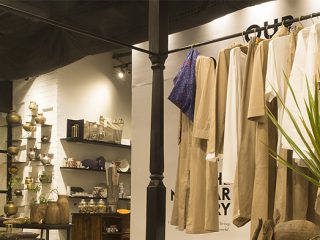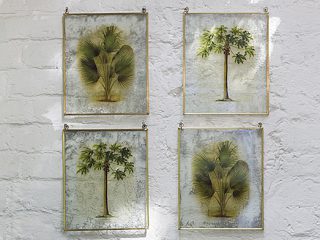From brick-and-mortar to Instagram becoming everyone’s personal front row, the fashion industry has transformed over the past decade
Changing. Digital. Fast.
According to McKinsey and Business of Fashion’s ‘The State of Fashion 2019’ report, these were the top three words used to describe the industry in 2018. A pretty succinct encapsulation of its evolution over the past decade too.
A telling sign is retail giant Zara’s window campaign from a few months ago, or the bold text on its shopping bags—even at the sprawling, always-packed store, the brand etched out a clear message: Dear India, shop online. The past 10 years have rewritten the consumption of fashion, both in India and around the world, and as with most other industries, this transformation has been spurred heavily by technology.

“In the past decade, we’ve seen the emergence of what we call modern retail,” says Ananth Narayanan, former CEO of fashion e-tailers Myntra and Jabong. “The decade can be divided into two phases. The first five years saw the rise of ecommerce, which multiplied reach and got brands into everyone’s homes, changing the nature of how Indians consume them; and in the second phase, mobile internet penetrated through the breadth of the country. This has had a dramatic impact on how consumers discover brands, thanks to social media, and caused a focal shift from traditional advertising to digital brand building.”
Three distinct trends define the current fashion industry, says Narayanan. One is a classic millennial trait—each brand must have a unique purpose, and authenticity. “That’s a fundamental change. Now, whether it’s Dior making T-shirts that say ‘We should all be feminists’ or Burberry going fur-free, brands often need to associate with what’s happening in the world,” he adds. “Since brands are built digitally, it matters to buyers what these companies stand for.”
The second trend is also connected to the fact that brands are built socially. “Consumers worry about what their friends think about what they wear, which means that someone sitting in Paris or New York is no longer dictating fashion trends,” says Narayanan.
“Brands that are successful in India have understood how [Indians] consume, what colour they consume, what kind of designs work, and personalisation may be very different from a consumer living in New York or Hong Kong,” The State of Fashion report quotes Sanjay Kapoor, founder of Genesis Luxury, which retails top international brands in India. “Indian women have kept a lot of their traditional sensibilities alive.”
In the global report’s top 10 market trend predictions for 2019, the number two forecast is ‘Indian ascent’. It says: India is increasingly a focal point for the fashion industry, reflecting a rapidly growing middle-class and increasingly powerful manufacturing sector. These, together with strong economic fundamentals and growing tech savvy, make India too important for international brands to ignore. “We are moving towards the gold-collar worker,” Kapoor adds in the study. “It’s a term that defines the well-paid and highly-paid professionals, who are happy to look good, happy to feel good and are expanding the consumption of today.”
The third trend, says Narayanan, is a move towards conscious, sustainable fashion. In the age of Instagram, fashion has acquired a whole new language. Storytelling has become as important as the design itself, and consumers are swiping and scrolling to find brands that stand out on a cluttered feed.
How has Indian fashion evolved for the digital runway, and where does it go from here?
The show must go on…line
A few years ago, Indian label Sabyasachi, known for its celebrity endorsements and high-powered show stoppers, sent waves of surprise through the fashion world. Sabyasachi Mukherjee, the founder of the eponymous label, decided he wouldn’t do fashion shows anymore, but instead, release entire collections on Instagram. In July 2016, he invited millions of followers to attend a virtual fashion show of sorts. With well-lit, artistic images and clear, full views of the outfits, the ‘show’ saw sizeable traction.
“I wanted to be relevant, and digital became more relevant,” Mukherjee says. “I looked at Instagram and thought, how can this be for free? I can put an outfit there, and people all over the world can see it. It’s like advertising. It’s like doing a show.”
Related stories
Disruptions of the last decade
Mukherjee recalls meeting a woman at a fashion week, who wasn’t a luxury buyer, but was window shopping Dior and Chanel on Instagram. “I realised that it’s the most democratic platform out there. I went back and told my team to cancel fashion week. We want to do a show on Instagram. Everyone’s personal runway, everybody’s own front row,” he says.
As a policy now, brand Sabyasachi doesn’t give out exclusive images to the press anymore. “Whatever is out there goes first to the consumer via social media, and the press can re-post,” he says. “There are thousands of people who want to get into my store, but are probably afraid to because of financial, cultural and language barriers. I want to invite them in.”
“Today, it’s not just about fashion shows,” agrees celebrity fashion designer Manish Malhotra, founder of his eponymous label. “Fashion photography has become as vital to communicate your story on social media. Shoots are now parallel to shows.”
Social media, says Malhotra, helps keep the fashion world on its toes. “I really enjoy it,” he adds. “I love the energy of new designers and stylists on it. It’s an important branding and storytelling tool.”
While Malhotra has done a fair share of fashion shows in the past three years, this year, the brand strategy has turned. “I think I did too many shows, perhaps because I enjoy them too much,” he confesses. “One big decision we’ve taken for the brand this year is to do fewer shows. I do think the nature of shows is changing, as it must. We need to really look into how to make presentations different.”
With multiple fashion weeks, he adds, often, things end up looking “too similar”. “Fashion weeks are evolving, and working to harness the power of social media, but they do need a new look,” he says. “We need to think of new versions of shows themselves.”
The way shows are devised, say designers, has changed significantly, geared more towards visual storytelling, and keeping in mind not just the clutch of the fashion fraternity physically present at the runway, but also the millions of followers who are tracking it on their smartphones.
“A good fashion show today is not just about the clothes, but about the music, drama, live performances—all tailored to create engaging visual content,” says designer Payal Singhal. “Earlier, shows were purely buyer events, without any frills. Today, it has to be larger than life, to make a significant impact to awareness as well as positioning.”
For Nicobar, a new-age e-store with modern, India-inspired clothing and accessories, content is key. The brand has an online magazine, Nico Journal, which features interviews with design and lifestyle entrepreneurs, how-to guides, recipes and more. “We have focussed on content to tell the product story, as opposed to spending marketing money,” says Raul Rai, CEO and co-founder, Nicobar. “To date, we have spent less than 7 percent of revenue on advertising, and more than 10 percent on content creation. For us, content and commerce are integrated, and communicating our inspiration and beliefs leads the strategy, versus pushing marketing plugs and messaging.”
Instagram and Facebook, says Rai, have had teams help Nicobar innovate with their storytelling. “The vocabulary we use is inspire vs sell; brand ambassador vs salesperson; delight vs transact,” he adds. “Content is independent of marketing in our reporting structure, though they work closely together. We think of ourselves as being two parts creative, one part business. We put out content from a publishing and editorial perspective to highlight interesting voices in design. That helps create a unique relationship with our audience.”
Social media has also led to a new and powerful category of direct marketing, using influencers and stylists to put out a certain product or collection. These part-bloggers part-models have forged a new career altogether, painstakingly putting together pretty grids and highly styled photographs, shot to showcase an aspirational lifestyle, where the clothes often seem incidental.
“These influencers or micro-celebrities, who are known for their unique aesthetic and style, play a pivotal role in portraying new designer lines to their ardent followers, who emulate their sense of style,” says designer Falguni Peacock.
Beyond borders
What will it take to make India a global fashion hub over the next decade? “We have the quality and the style. We have no dearth of talent. We have the best craftspeople and artisans and design DNA. International designers are already hugely inspired by India, our embroidery, colours and silhouettes,” says Abu Jani, one-half of celebrity designer duo Abu Jani Sandeep Khosla. “What we lack is investment, from both the public and private sectors. We need to put money where it is needed—infrastructure, marketing, training, lobbying. We need to position ‘Made in India’ as world-class.”
“India is so rich culturally, and our fashion oozes luxuriousness, whether it’s the Mughal style or the colours, fabric, handloom, textiles, textures or embroidery,” adds Malhotra. “There’s so much diversity in design, when you look at regions as different as Rajasthan, Gujarat, Kutch, Kolkata… what designers need to go global is international backing.”
Going to an international market is difficult, he says. “I would look at my own work and restyle it for another part of the world,” he says. “Today, fashion is at its peak. There are so many mediums of sale, purchase and storytelling. We should celebrate this new wave and push ourselves harder.”
A part of this expansion story will find its voice through Indian consumers, say experts, who will become the global ambassadors of Indian fashion. “The consumer of fashion has evolved to become conscious and proud of wearing Indian creations, whether it’s for a formal red carpet evening, a wedding or even a cocktail or lunch event,” says Monica Shah, owner of fashion label JADE. “There is pride in being modern with an Indian soul, being global and yet having a local appeal. The Indian consumer has become much more open-minded. This wasn’t the case a decade ago.”
“There used to be a trickle-down theory in India where the poor used to dress like the rich,” adds Mukherjee. “Now, the rich have started dressing like the poor. They are suddenly asking for no zari—which was the differentiator—they want cotton instead. They don’t want a gown, but a simple sari. They want to be respected for who they are, not what they wear. Fashion is going through a phase right now where the democracy of choice is going to drive luxury. In this, we’re in a good space.”
For Mukherjee, too, now is the time to break borders. “For the past 20 years, I’ve put my head down and only focussed on India. I needed to first find my local identity. I was a Bengali designer first, then I became a national designer. The last year was a culmination, when I did whatever I had to do as a wedding designer. So for 20 years I’ve been doing clothes with a market in mind. Now, I’m just opening my voice out to the universe, for whoever wishes to have me or find me.”
Fashion forward
Another aspect that could drive Indian fashion’s global rise is its unique blend of high-quality artistry with the quick adoption of technology. “We’re growing well in digital and e-commerce, but a lot more can be done in manufacturing,” says Narayanan. “We have great opportunity globally if we can change processes in both hardware and software, using artificial intelligence (AI) and machine learning (ML) for intelligent fashion.”
For Narayanan, sustainability and fast fashion are not trends that are at odds with each other. “With digitised fast fashion, we can have more efficiency and less wastage,” he adds. “For instance, you can 3D-manufacture for quantities as low as one, but make it as economically as quantities of 500. This way, customers will have much more personalisation, and we will save on a lot of wasted material, as these are small batch collections.”
Narayanan also says the next big thing will be using AI and ML to study global trends, and use data analytics to design collections without human intervention. “The answer is staring at us: Using anonymised data signals from the millions of customers who browse various platforms to better predict what customers want,” he says.
“I believe this is a very small beginning to how we can use data, algorithms and machine-vision technology to start to disrupt what’s been traditionally a very ‘art’-oriented industry,” he says. “I do not for one minute believe that this will replace creativity worldwide. However, I do believe that having better data and tools will help them and the entire industry reduce waste and deliver much better value and experiences to the customer.”
(With inputs from Naini Thaker and Naandika Tripathi)
(This story appears in the 24 May, 2019 issue of Forbes India. You can buy our tablet version from Magzter.com. To visit our Archives, click here.)





